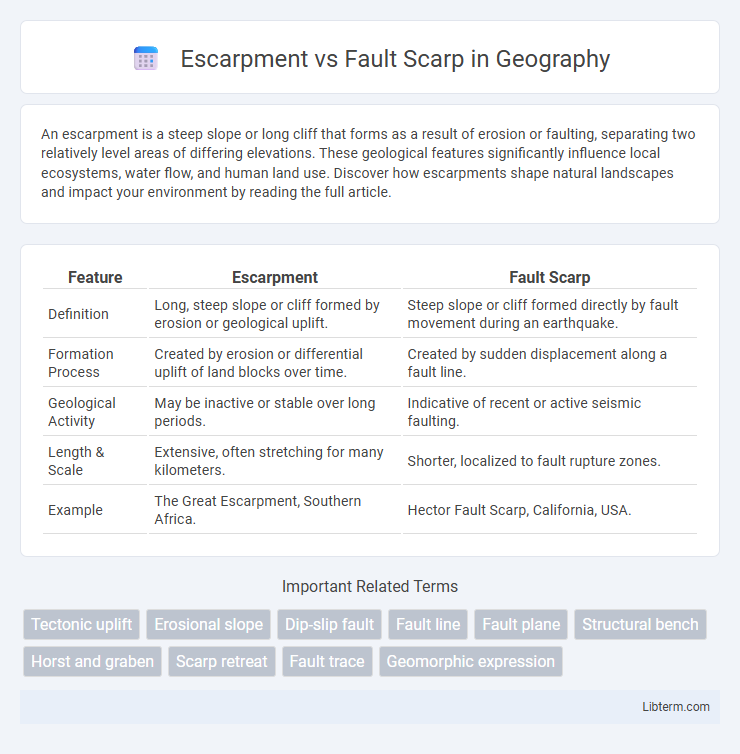An escarpment is a steep slope or long cliff that forms as a result of erosion or faulting, separating two relatively level areas of differing elevations. These geological features significantly influence local ecosystems, water flow, and human land use. Discover how escarpments shape natural landscapes and impact your environment by reading the full article.
Table of Comparison
| Feature | Escarpment | Fault Scarp |
|---|---|---|
| Definition | Long, steep slope or cliff formed by erosion or geological uplift. | Steep slope or cliff formed directly by fault movement during an earthquake. |
| Formation Process | Created by erosion or differential uplift of land blocks over time. | Created by sudden displacement along a fault line. |
| Geological Activity | May be inactive or stable over long periods. | Indicative of recent or active seismic faulting. |
| Length & Scale | Extensive, often stretching for many kilometers. | Shorter, localized to fault rupture zones. |
| Example | The Great Escarpment, Southern Africa. | Hector Fault Scarp, California, USA. |
Introduction to Escarpments and Fault Scarps
Escarpments are steep slopes or long cliffs formed by differential erosion or tectonic processes, representing significant elevation changes in the landscape. Fault scarps specifically result from vertical displacement along a fault line, marking the exposed surface where the earth's crust has shifted. These geological features provide critical insights into tectonic activity and landscape evolution.
Defining Escarpment: Formation and Characteristics
An escarpment is a steep slope or long cliff formed by processes such as erosion or faulting, representing a significant change in land elevation. It typically results from differential erosion where harder rock layers resist weathering more than underlying softer layers, creating a pronounced ridge. Escarpments often stretch for considerable distances, serving as prominent topographical features that can influence drainage patterns and local ecosystems.
Understanding Fault Scarp: Key Features and Origins
A fault scarp is a steep slope or cliff formed directly by the vertical displacement of the Earth's crust along a fault line during an earthquake or tectonic activity. Unlike a general escarpment, which can result from various geological processes such as erosion or differential weathering, a fault scarp specifically indicates recent or active fault movement, making it a crucial marker in seismology and structural geology. Key features include sharp, linear ridges aligned with fault traces, abrupt changes in elevation, and frequently visible offset landforms, which help geologists identify seismic hazards and study earthquake history.
Geological Processes Behind Escarpments
Escarpments form through long-term geological processes such as erosion, differential weathering, or tectonic uplift, creating steep slopes that separate two relatively level areas. Fault scarps specifically result from sudden vertical displacement along a fault line during seismic activity, revealing a fresh and often sharp cliff face. The geological distinction lies in escarpments representing gradual landscape evolution, while fault scarps are abrupt, direct evidence of fault movement.
Tectonic Movements and Fault Scarp Development
Escarpments and fault scarps both result from tectonic movements but differ in formation processes and characteristics. Escarpments are long, continuous steep slopes formed by regional tectonic uplift or differential erosion, while fault scarps specifically develop from vertical displacement along a fault line during seismic activity. Fault scarp development directly reflects the magnitude and direction of fault movement, providing key evidence of recent tectonic activity and earthquake history.
Differences Between Escarpments and Fault Scarps
Escarpments are long, steep slopes or cliffs formed by various geological processes such as erosion or tectonic activity, while fault scarps specifically result from displacement along a fault line due to earthquakes or crustal movements. Fault scarps exhibit a distinct linear break in the Earth's surface directly tied to faulting, typically characterized by abrupt vertical displacement over a short distance. Escarpments may cover broader areas with varied origins, whereas fault scarps provide clear evidence of recent tectonic activity and fault slip events.
Examples of Famous Escarpments Worldwide
The Great Escarpment in Southern Africa, the Drakensberg Mountains, and the Niagara Escarpment in North America are prime examples of famous escarpments formed by long-term erosion and tectonic uplift. In contrast, fault scarps like the San Andreas Fault in California and the Huang He Fault in China result directly from sudden vertical displacement during earthquakes. These natural features highlight the distinct geological processes shaping escarpments and fault scarps worldwide.
Notable Fault Scarps Across the Globe
Notable fault scarps such as the San Andreas Fault in California and the Alpine Fault in New Zealand showcase dramatic vertical displacements caused by tectonic movements, distinguishing them from typical escarpments formed primarily by erosion or uplift. The Himalayan front exhibits extensive fault scarps resulting from the ongoing collision between the Indian and Eurasian plates, highlighting the role of seismic activity in shaping these landforms. These fault scarps provide critical insights into earthquake mechanics and crustal deformation processes worldwide.
Importance in Geomorphology and Earth Science
Escarpments and fault scarps are critical features in geomorphology, highlighting Earth's structural and tectonic processes. Escarpments represent steep slopes formed by differential erosion or faulting, serving as indicators of landscape evolution and crustal deformation. Fault scarps specifically expose the vertical displacement along active faults, essential for assessing seismic hazards and understanding fault mechanics.
Impacts on Human Activities and Landscapes
Escarpments and fault scarps both shape landscapes but differ significantly in formation and impact. Escarpments, formed by erosion or tectonic uplift, create natural barriers influencing settlement patterns, agriculture, and transportation routes, often promoting biodiversity in steep terrains. Fault scarps, resulting from sudden fault displacement during earthquakes, pose direct hazards to infrastructure and communities by causing ground rupture, landslides, and altering drainage systems in affected areas.
Escarpment Infographic

 libterm.com
libterm.com